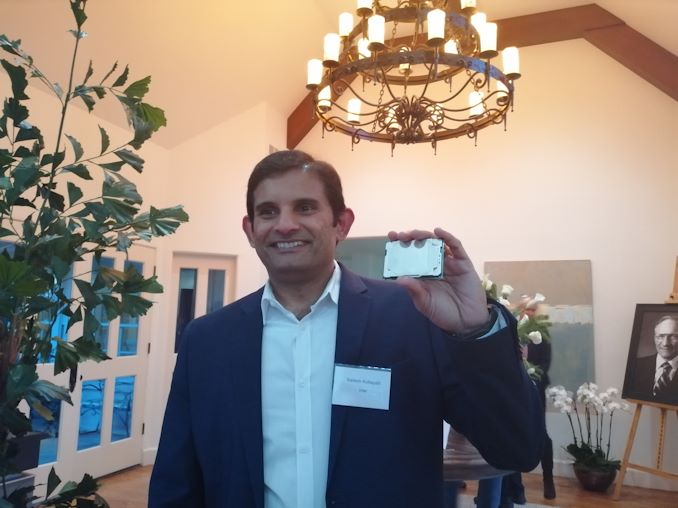Intel's Architecture Day 2018: The Future of Core, Intel GPUs, 10nm, and Hybrid x86
by Dr. Ian Cutress on December 12, 2018 9:00 AM EST- Posted in
- CPUs
- Memory
- Intel
- GPUs
- DRAM
- Architecture
- Microarchitecture
- Xe
Ice Lake 10nm Xeon Scalable On Display
One of the more sedate talks at the event was discussing Intel’s approach in the datacenter. We’ve covered this story in detail, especially at Intel’s Data-Centric Summit only a few months ago. Intel has stated that Cascade Lake and Cooper Lake are the next two products for the enterprise market, both built on 14nm, focusing on enhanced security as well as AI instructions to help with acceleration. We also know that after these two Intel will have Ice Lake Scalable built on 10nm, but that’s about it.
To be honest, we don’t actually know much more than what we did back then. Intel confirmed that Ice Lake will be built using Sunny Cove cores. But Intel also showed off what they said was an Ice Lake Xeon 10nm processor and package, as shown in the image above.
Color me skeptical, but what was held up is likely either not ICL-SP or just silicon that doesn’t work. In order to make those products, Intel would have to have pumped out at least one large (350mm2+?) die that worked and then put it into a package with a heatspreader. Intel finally seems to be happy discussing a few products on 10nm, as shown at this event, but all the 10nm hardware is based on tiny 100mm2 or smaller silicon. Given Intel’s documented problems, I would have loved that CPU that was held up in the air to be Ice Lake-SP. But I’ll need to see something more concrete to believe it at this point; it’s too much of a jump.
Ending Intel’s Architecture Day
As I’m writing this, it is 3am PT and only a couple of hours away from Intel’s listed embargo time. The event finished 10 hours ago (a few of us skipped the end event drinks to get to writing) and despite the short time to write it all up, it was a good event overall. For the first time in a good while, Intel decided to talk shop, and in an honest way with very little hand waving. One could argue that in every discussion point, Intel raised more questions than they answered, but the positive here is that questions are being answered, and Intel is willing to share things like roadmaps into 2021, demonstrations of some exciting new products for 2019/2020, and a taste of how they are progressing in both manufacturing and microarchitecture. Hopefully Intel will feel the same and this can become a yearly cadence. The trio of Keller, Koduri, and Murthy, is a strong team to field to the press, and this event fits that bill.
To end this piece, I’m going to put in the Q&A section from day’s presentations, as well as some of the questions put in my particular round-table. It’s an interesting read, and it helps that Jim is full of memorable quotes.











148 Comments
View All Comments
Spunjji - Thursday, December 13, 2018 - link
Is it better? Their last roadmaps were not worth the powerpoint slides they showed up in, not to mention the whole "tick-tock-optimise-optimise-delay" fiasco.HStewart - Thursday, December 13, 2018 - link
From the look of things in this excellent article - it looks for 2019 Intel is combining both tick and tock together with significant architexture improvement along with process improvements.johannesburgel - Thursday, December 13, 2018 - link
Compared to the latest Xeon roadmaps I have seen in NDA meetings, these desktop roadmaps still seem quite ambitious. They don't expect to ship a "lower core count" 10nm Xeon before mid-2020.HStewart - Thursday, December 13, 2018 - link
Just because Intel did not mention it - does not mean it will not happen.Also remember that Intel is decoupling the process from actual Architexture. In the past, I alway remember the Xeon technologies were forerunner's of base core technology. Hyperthreading is one example and multiple core support.
Vesperan - Wednesday, December 12, 2018 - link
Its 6am for me, and with the mugshots of Jim Keller and Raja Koduri at the end you could have labelled this the AMD architecture day and I would have believed you. It will be an interesting several years as those two put their stamp on Intel CPU/GPUs.The_Assimilator - Wednesday, December 12, 2018 - link
So Intel is going to take another poke at the smartphone market it seems. Well, let's hope Fovoros fares better than the last half-dozen attempts.Rudde - Wednesday, December 12, 2018 - link
7W is too much for a smartphones power budget. Smartphones operate at sub 1W power budget.johannesburgel - Wednesday, December 12, 2018 - link
The just announced Qualcomm Snapdragon 855 has a peak TDP of 5 Watts. Most smartphone manufacturers limit the whole SoC to 4 watts. The average smartphone battery now has >10 Wh, so even at full load the device would still run between 1.5 (display on) and 3 (display off) hours. Which it has to in the hands of those gamer kids.YoloPascual - Wednesday, December 12, 2018 - link
Had the og zenfone with the intel soc. It drains battery as a gas guzzler suv. Never buying a smartphone with intel inside ever again.Mr Perfect - Wednesday, December 12, 2018 - link
It's exciting to see Intel use FreeSync in their graphics. They could have easily gone with some proprietary solution, then we'd have three competing monitor types. Hopefully having both AMD and Intel on FreeSync will prompt Nvidia to at least support it alongside G-Sync.